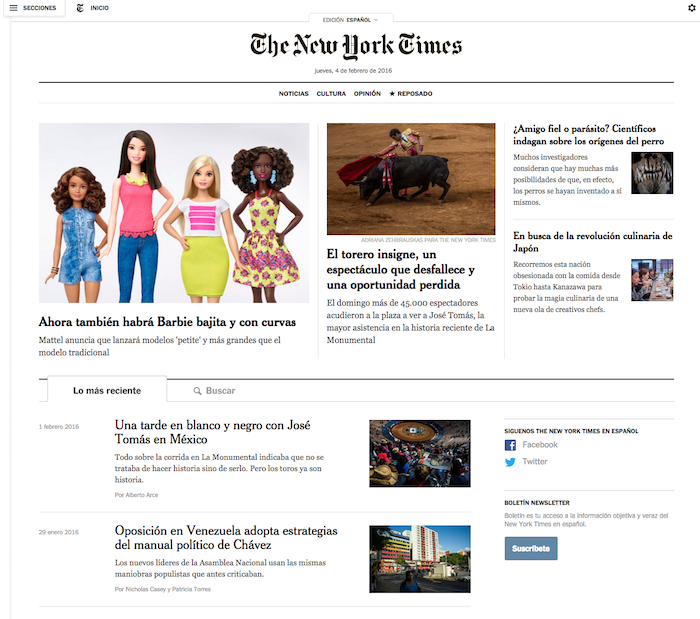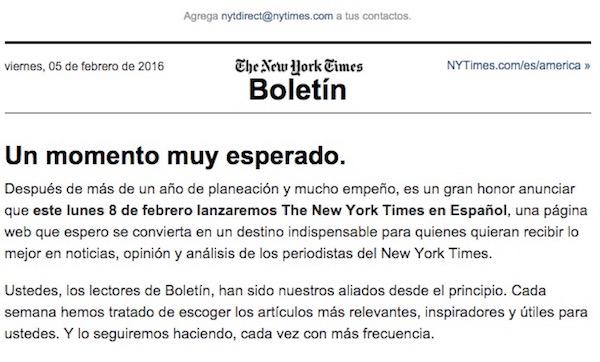En Español:
The New York Times launches a Spanish-language news site aiming south of the border
The New York Times en Español is the Times’ latest attempt to grow its audience internationally.
The Iowa caucuses are confusing. Every four years, Americans receive a crash course in the quirky midwestern custom that kicks off the presidential nominating cycle, but for news consumers abroad — even those who follow U.S. politics — the process can be even more mystifying.
So before Iowans caucused last week, The New York Times published a story in Spanish to explain how the caucuses work and what their impact will be on the rest of the campaign.

“This team, and future teams that we build in other places, can be a bridge — not just to bring Times journalism to those places, but also to explain the United States and all the things that happen here to those audiences,”Lydia Polgreen, the deputy international editor who oversaw editorial development of the project told me.
Elias Lopez is the site’s editorial director, and he’ll be working with a team of six journalists.
In addition to the site that the Times is debuting today, it’s also launching a twice-weekly newsletter, Boletín.

“We’ll be exploring different models as time goes on,” Polgreen said. “This is a beta project. We’re learning. We’re trying to understand the audience. We’re trying to understand the value.”
The Times decided to focus on a Spanish product first because the language is so widely spoken (a Spanish government report last year estimated that there are 559 million Spanish speakers globally, including 470 million native speakers). That many Spanish-speaking countries are near the United States meant the staff didn’t have to battle time zones or travel far to conduct research.
The paper expects its largest audiences for the new product to come from Mexico, Argentina, Colombia, and Spain. There is also a sizable audience of Spanish speakers in the United States.
Polgreen wouldn’t specify which other regions the Times is targeting for future expansion, but she said the paper would probably try to replicate the curated approach even if it’s entering a predominantly English-speaking market.
For now, the Spanish site will be free to access, and its stories won’t count against the Times’ paywall. Polgreen said the Times plans to continue to “experiment with a lot of different potential models, paid and not” as it grows internationally. “Our main goal in this is to get people to think of The New York Times as an important part of their daily lives,” she said.
Polgreen said she considers The New York Times en Español an extension of the Times’ current products. “We don’t have a separate brand for it,” she said. “The truth is, people want to read The New York Times, and they want to read the Times’ marquee journalists. That’s what’s most appealing to them.”
Polgreen has led the editorial side of the project. Paul Walborsky, the former Gigaom CEO who has been consulting for the Times since late 2014, worked on the business side. Polgreen said she and Walborsky were “joined at the hip” throughout the process. Others on the team worked on design, product development, and data science.
Over the past year or so, Polgreen and others have taken multiple trips to the region to conduct research on the market. On one, Polgreen walked around Mexico City getting her shoes shined at multiple places, and asking the shoeshiners how their customers typically consume their news. Polgreen learned that before work in the mornings, people tended to read hard news on their phones. After lunch, they moved to one of the many Mexican celebrity tabloids. Team members also commuted with people on the subway to understand how they use their phones to consume news.
“I was a foreign correspondent for ten years,” Polgreen said. “I’ve always had the instinct to go out and talk to people, but it was really interesting to take that approach and apply it to developing a product.”
Because the Times wants to reach users through the Spanish-speaking world in Latin America as well as Spain, the team of journalists in Mexico City running the project are all native Spanish speakers who hail from around Latin America and Spain. Times staffers in New York and the Times’ correspondents throughout Latin America will also contribute to the site.
“We wanted to have a staff that crossed the Spanish-speaking world because our hope was to come up with a tone and a language that would be accessible to everyone,” Polgreen said. “We have a group of people who can talk together and say, ‘This word means this in Mexico, but does it sound different to a Colombian ear?’ Having that real-time back-and-forth ensures that we’re getting high-quality translations and using as neutral a Spanish as possible,” Polgreen said.
For now, the team will focus primarily on translated stories, but Polgreen said the Times could pursue more original Spanish stories if the demand from readers is there.
“We’re starting with a largely translated project with a significant component of original reporting, but as we build an audience, as we understand the needs of that audience, we can make deeper investments in original reporting based on what we learn,” she said. “We’re trying to backload rather than front load these investments.”
PHOTO OF MEXICO CITY BY ENEAS DE TROYA USED UNDER A CREATIVE COMMONS LICENSE.






No comments:
Post a Comment